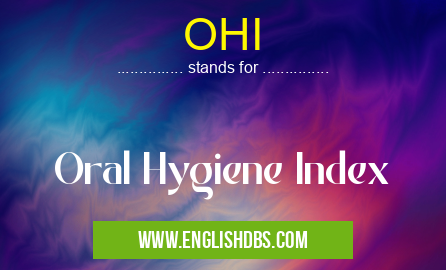What does OHI mean in UNCLASSIFIED
Oral Hygiene Index (OHI) is a dental scoring system used to assess the health and cleanliness of an individual's oral cavity. It is a widely accepted method for evaluating oral hygiene practices and identifying areas that require improvement.

OHI meaning in Unclassified in Miscellaneous
OHI mostly used in an acronym Unclassified in Category Miscellaneous that means Oral Hygiene Index
Shorthand: OHI,
Full Form: Oral Hygiene Index
For more information of "Oral Hygiene Index", see the section below.
OHI Measurement
The OHI is measured through a clinical examination conducted by a dental professional. The examination involves assessing the presence and severity of:
- Dental plaque: Soft, sticky biofilm that accumulates on teeth.
- Calculus (tartar): Hardened mineral deposits that form on teeth and below the gum line.
- Gingivitis: Inflammation of the gums.
OHI Scoring
Each tooth surface is scored on a scale of 0 to 3:
- 0: No plaque or calculus.
- 1: Plaque or calculus covering less than one-third of the surface.
- 2: Plaque or calculus covering one-third to two-thirds of the surface.
- 3: Plaque or calculus covering more than two-thirds of the surface.
The scores for all tooth surfaces are then added up to provide an OHI score.
OHI Interpretation
An OHI score of 0 indicates excellent oral hygiene, while higher scores indicate poorer oral hygiene. The following ranges are commonly used to interpret OHI scores:
- 0-3: Excellent
- 4-6: Good
- 7-9: Fair
- 10-12: Poor
- 13 or higher: Very poor
Essential Questions and Answers on Oral Hygiene Index in "MISCELLANEOUS»UNFILED"
What is the Oral Hygiene Index (OHI)?
The Oral Hygiene Index (OHI) is a scoring system used by dental professionals to assess the level of oral hygiene maintained by a patient. It is based on the presence of dental plaque and calculus (tartar) on specific tooth surfaces.
How is the OHI calculated?
The OHI is calculated by examining six tooth surfaces (facial, lingual, mesial, distal, vestibular, and palatal) for each of the six index teeth (16, 11, 21, 26, 36, 31). Each surface is scored as follows:
- 0: No plaque or calculus
- 1: Plaque covering less than one-third of the surface
- 2: Plaque covering one-third to two-thirds of the surface
- 3: Plaque covering more than two-thirds of the surface
- 4: Calculus present on the surface The scores for all six surfaces are added together to give a total OHI score.
What is a good OHI score?
An OHI score of 0 indicates excellent oral hygiene, while a score of 6 or more indicates poor oral hygiene. The ideal OHI score is typically considered to be 1 or less.
What factors can affect the OHI score?
Several factors can influence the OHI score, including:
- Frequency and thoroughness of toothbrushing
- Use of dental floss or other interdental cleaning aids
- Saliva flow rate
- Dietary habits
- Systemic health
Why is OHI important?
The OHI is important because it provides dentists with an objective measure of a patient's oral hygiene practices. It can help dentists identify areas where a patient may need to improve their oral hygiene routine and can be used to monitor the effectiveness of oral hygiene interventions.
Final Words: The OHI is a valuable tool for dental professionals to evaluate oral hygiene and provide personalized recommendations for improvement. By monitoring OHI scores over time, individuals can track their progress and maintain optimal oral health.
